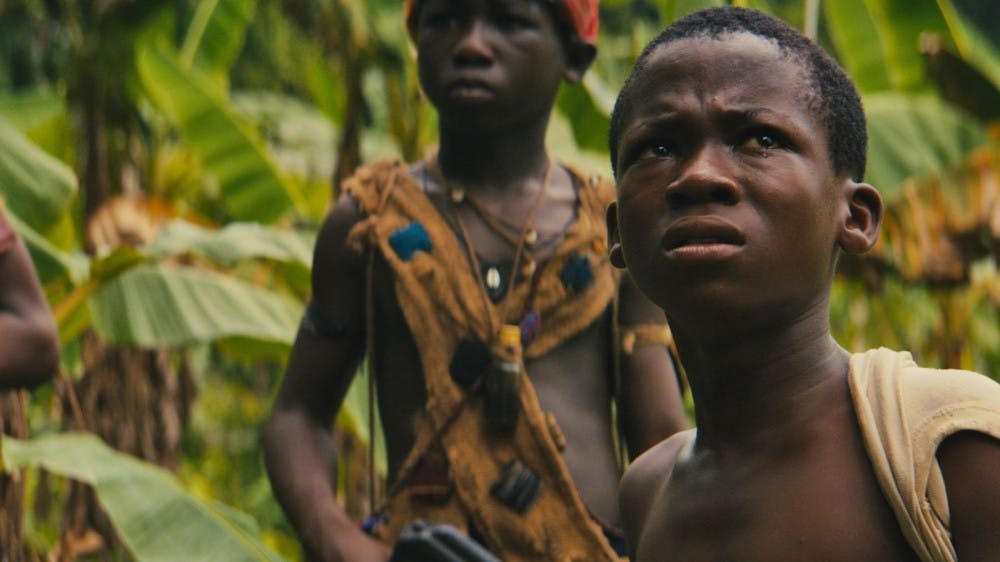Last Thursday, Uzodinma Iweala, both a doctor and a writer, came to the Kelly Writers House to speak with Penn students interested in his work. The accomplished writer shared his experiences about writing his popular novels (Beast of No Nation, 2005 and Our Kind of People: Thoughts on HIV/AIDS in Nigeria, 2012) and his life experiences—as a doctor, as a human and as a Nigerian–American writer.
His first novel, Beast of No Nations, focuses on the story of Agu, a young boy who is forced to enlist in a soldier troop in a West African country in the midst of civil war. The book is a graphic depiction of the lives of child soldiers and the collective trauma of war on a population. The book is in first person narrative, and the intimacy readers develops with the reader makes it a visceral read. The novel was conceived through Iweala's thesis at Harvard, and it has gone on to become both a bestseller and a major motion film. More importantly, however, it has become a modern narrative of brutal civil wars, and the effects on conflict on people.
Iweala's appearance at the Kelly Writers House prompted Street to compile 20th and 21st centuries of narratives and novels of conflict and displacement, but most importantly, resilience. These are stories that should be read, and shared.

Who wrote it? Chimamanda Ngozi Adichie
What is it about? The novel narrates the stories of five characters: two twin sisters, a professor, an English citizen and a houseboy before and during the bid for Biafran Independence from Nigeria.
Why should you read it? "Half of a Yellow Sun" memorializes a war that has been largely forgotten outside of the borders of Nigeria. Adichie uses history to understand the present through the voice of a powerful storyteller who personalizes narratives of history long gone. A seriously fantastic author (seriously, read her stuff if you haven't), she shows how the lives of people are shaped by the turmoils of civil war. If not for good, compelling writing, read to remember.
Who wrote it? Ru Freeman
What is it about? The Herath family moves to Sal Mal Lane in 1979, and from their house on a quiet street they witness the times past, present and future ravaging effects of civil war.
Why should you read it? This novel handles topics of conflict in a masterful way—by presenting the story of a family before and during civil war through the beautifully depicted Herath family. The story is gut–wrenching because of readers' hindsight—for we know that things as they are before the civil war cannot last forever, but the characters do not know this. Freeman also has an incredible mastery of language, and is able to paint the story in a complex, humane and sometimes even humorous way. She takes readers through a range of emotions that ultimately make this a complete, perspective–changing narrative.
What is it about? A narrative set in the Dominican Republic during the Trujillo dictatorship about the Mirabal sisters, a set of valiant siblings who opposed the authoritarian regime.
Why should you write it? This is a nonfiction told as fiction that depicts the tragic yet brave story of the Mirabal sisters, who resisted the totalitarian, violent, and bloody Trujillo dictatorship. Read if you want to read about strong, historical women—who coincidentally serve as the protagonists of this story—not to mention that the book is incredibly well written.
Who wrote it? Sadie Jones
What is it about? The story of a British soldier and his wife during 1950s Cyprus during a period war time.
Why should you read it? The novel follows a military married couple who are navigating through the island nation—and their falling out in the light of a colonialist conflict. Read if you want a novel that depicts charged moments masterfully and explores British identity through a juxtaposition with its environment, as well as the consequences of war on intrapersonal relationships and individuals.
Who wrote it? Slavenka Drakulić
What is it about? The novels is set in 1992 during the climax of the Civil War; it is the experience of a woman and survivor of rape by occupying soldiers who gives birth to an unwanted child in in exile. Through flashbacks, S. bravely reveals the unspeakable horrors of war and its aftermath from abroad.
Why should you read it? The systematic rape of women was a war strategy which was widely and brutally implemented during the 1990s Balkan Wars. Yet, it was a topic not widely discussed until years later--in part because of the awful, awful consequences such actions had on rape and sexual assault survivors. Though this novel might be fiction, it is based on the stories of real women.

Matternhorn: A novel of the Vietnam War
Who wrote it? Karl Marlantes
What is it about? Marlantes, who commanded a Marine rifle platoon, draws upon his own experiences of war to craft a 600– page novel in the traditional of war epics.
Why should you read it? Matterhorn is the narrative of a man trying to make sense of his years during the Vietnam War and about finding redemption and healing through literature. Read to follow a veteran in his journey of healing through writing—but also through remembrance.





